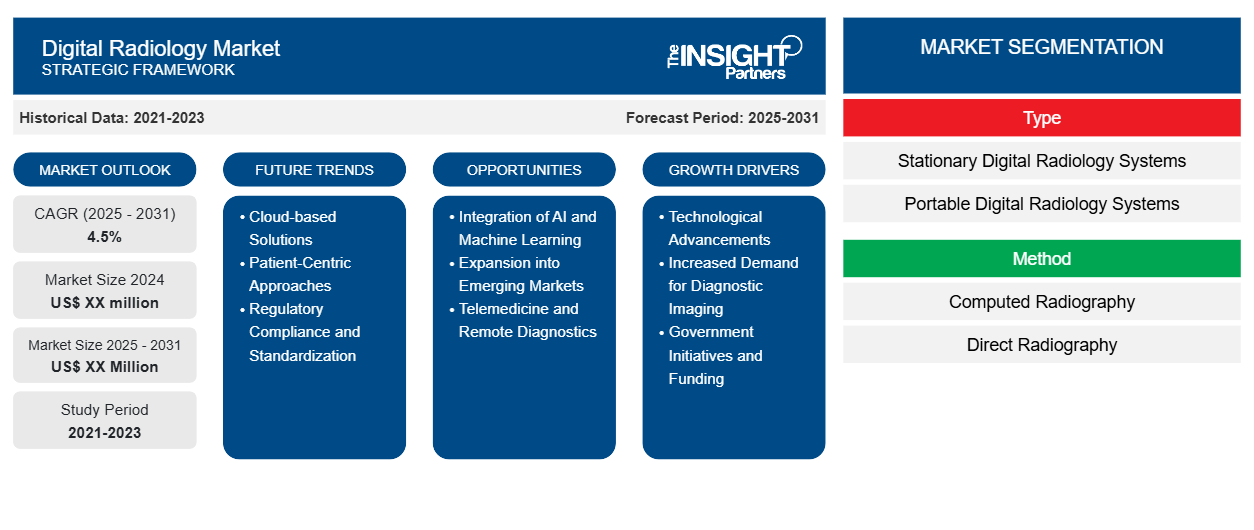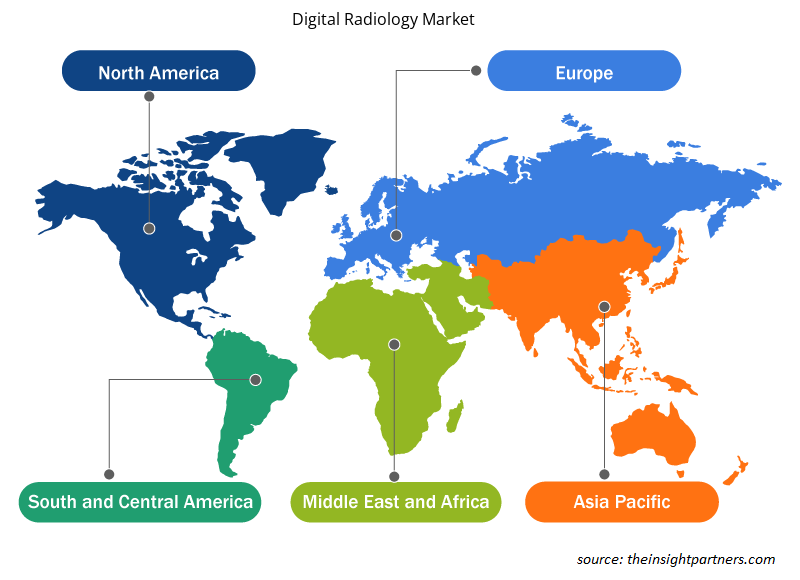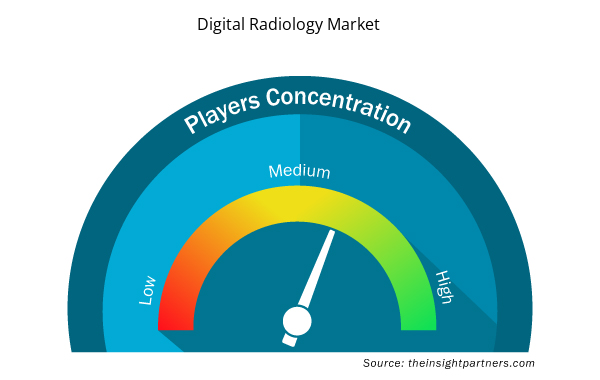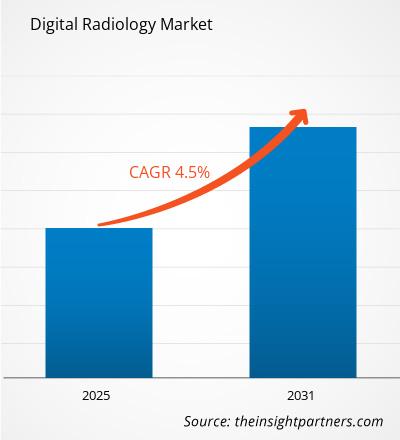The Digital Radiology Market is expected to register a CAGR of 4.5% from 2025 to 2031, with a market size expanding from US$ XX million in 2024 to US$ XX Million by 2031.
The report is segmented by Type (Stationary Digital Radiology Systems, Portable Digital Radiology Systems). The report further presents analysis based on the Method (Computed Radiography (CR), Direct Radiography (DR)). The report is segmented by Application (Cardiovascular Imaging, Chest Imaging, Dental Imaging, Mammography Imaging, Orthopedic Imaging, Others). The report is segmented by End User (Hospitals and Clinics, Diagnostic Centers, Others). The global analysis is further broken-down at regional level and major countries. The Report Offers the Value in USD for the above analysis and segments.
Purpose of the Report
The report Digital Radiology Market by The Insight Partners aims to describe the present landscape and future growth, top driving factors, challenges, and opportunities. This will provide insights to various business stakeholders, such as:
- Technology Providers/Manufacturers: To understand the evolving market dynamics and know the potential growth opportunities, enabling them to make informed strategic decisions.
- Investors: To conduct a comprehensive trend analysis regarding the market growth rate, market financial projections, and opportunities that exist across the value chain.
- Regulatory bodies: To regulate policies and police activities in the market with the aim of minimizing abuse, preserving investor trust and confidence, and upholding the integrity and stability of the market.
Digital Radiology Market Segmentation
Type
- Stationary Digital Radiology Systems
- Portable Digital Radiology Systems
Method
- Computed Radiography
- Direct Radiography
Application
- Cardiovascular Imaging
- Chest Imaging
- Dental Imaging
- Mammography Imaging
- Orthopedic Imaging
- Others
End User
- Hospitals and Clinics
- Diagnostic Centers
- Others
Customize This Report To Suit Your Requirement
You will get customization on any report - free of charge - including parts of this report, or country-level analysis, Excel Data pack, as well as avail great offers and discounts for start-ups & universities
Digital Radiology Market: Strategic Insights

- Get Top Key Market Trends of this report.This FREE sample will include data analysis, ranging from market trends to estimates and forecasts.
Digital Radiology Market Growth Drivers
- Technological Advancements: The main impetus of digital radiology is fast-paced technological advancement. Advanced image technologies, such as computed radiography (CR) and digital radiography (DR), improved the quality of images and thereby diagnostic ability. They also save quite a lot of time in acquiring and processing images, providing healthcare providers with an up-to-date and well-informed alternative. Advances in AI and ML also enhance image analysis, which is capable of detecting conditions that a naked eye would simply miss. The technologies are continually advancing, and their implementations create more and more demand for digital solutions to radiology.
- Increased Demand for Diagnostic Imaging: In the recent past, diagnosis, including cancer, cardiovascular diseases, and orthopedic conditions, has taken a tremendous pace. As the world's population is getting older, there's a need for early diagnosis and proper treatment of such conditions, and hence the non-invasive diagnostic processes of digital radiology have raised its demand in hospitals and clinics to diagnose such diseases. Another aspect is that preventive care is now gaining much importance; hence, healthcare service providers are seeking digital imaging solutions in a way to allow early detection of diseases.
- Government Initiatives and Funding: The governments around the world realize that increased access to advanced diagnostic tools will help them overcome the adverse effects on health. Some countries have already started implementing funding programs and policies that support the adoption of digital radiology technologies. For example, spending in healthcare infrastructure through reforms in healthcare is a common trend where investments are also made in digital imaging solutions. Access to quality diagnostic imaging will increase not only the facilities coming up with their systems in digital formats but also encourage healthcare facilities to upgrade their systems to digital formats.
Digital Radiology Market Future Trends
- Cloud-based Solutions: There is an uptake of cloud-based solutions in digital radiology. The various technological configurations offer advantages like improved data storage, better communication among the medical professionals, and access to patient history files. Digital radiologists can retrieve images and data anywhere because they are stored on cloud technology. This aids them in offering second opinions through remote consultations. Hence, this development not only promotes the efficiency of workflow but also saves on high costs from expansive on-premise IT infrastructure for health facilities.
- Patient-Centric Approaches: Such a trend is seen toward patient-centric orientations in all healthcare services, including that of digital radiology. This consequently puts more pressure on the need for transparency and the individual's right to access medical information, making the demand for them to be more integral to their decisions grow. Digital radiology solutions that allow easy access of imaging results to patients and also make communication with health care providers possible gain more ground. It's a trend that basically speaks about the education and engagement of a patient in every health care service.
- Regulatory Compliance and Standardization: The trend regarding the use of digital radiology has been growing in terms of regulatory compliance and standardization. As it is evident that data generation through imaging technologies has reached a considerable high, regulatory bodies emphasize the need for standardized protocols both for safety and efficacy in imaging practices. Regulations such as the Health Insurance Portability and Accountability Act in the United States, or similar regulations in other parts of the world, represent critical regulatory hurdles for digital solutions in radiology. Firms that emphasize compliance or observe industry standards will seal and reinforce their reputation as solid and trustworthy players in the market.
Digital Radiology Market Opportunities
- Integration of AI and Machine Learning: Digital radiology will open up wide growth opportunities in the market when integration of artificial intelligence and machine learning takes place. This may further improve interpretation, optimization of workflow, and reduction of man-related errors. It goes as far as automation of routine tasks where radiologists would spend more time on complex assessment. This consequently leads to improvement in patient care. Companies making AI-based solutions on image interpretation and diagnostics have a goldmine to exploit in this trend through providing a tool that will help radiologists in giving the most accurate diagnosis in less time.
- Expansion into Emerging Markets: An emerging market is also coming in as a growth opportunity for digital radiology. Improving health care infrastructure in countries located in Asia, Africa, and Latin America will cause demand for advanced diagnostic imaging solutions to increase. Investments are likely to be fruitful since health facilities will look for ways of embracing modern technologies that enhance their diagnostic capabilities. Similarly, those companies that provide such services adapt their products according to the needs of their specific markets for example in terms of affordability and usability.
- Telemedicine and Remote Diagnostics: Telemedicine and other remote diagnostics have already started changing the whole face of healthcare service delivery. Digital radiology has emerged as an integral ingredient in this transformation as it can facilitate effective and rapid image and report exchange across providers. Telehealth services are grossly expanding, and as are the vast opportunities for digital radiology solutions, where second opinions and consultation with several specialists can be taken remotely from any remote location, which further opens out the possibilities of healthcare. As healthcare systems go on to adapt to increasingly decentralized care models, the market will grow for companies developing platforms that make it easier to fully integrate digital imaging with telemedicine.
Digital Radiology Market Regional Insights
The regional trends and factors influencing the Digital Radiology Market throughout the forecast period have been thoroughly explained by the analysts at Insight Partners. This section also discusses Digital Radiology Market segments and geography across North America, Europe, Asia Pacific, Middle East and Africa, and South and Central America.

- Get the Regional Specific Data for Digital Radiology Market
Digital Radiology Market Report Scope
| Report Attribute | Details |
|---|---|
| Market size in 2024 | US$ XX million |
| Market Size by 2031 | US$ XX Million |
| Global CAGR (2025 - 2031) | 4.5% |
| Historical Data | 2021-2023 |
| Forecast period | 2025-2031 |
| Segments Covered |
By Type
|
| Regions and Countries Covered | North America
|
| Market leaders and key company profiles |
Digital Radiology Market Players Density: Understanding Its Impact on Business Dynamics
The Digital Radiology Market market is growing rapidly, driven by increasing end-user demand due to factors such as evolving consumer preferences, technological advancements, and greater awareness of the product's benefits. As demand rises, businesses are expanding their offerings, innovating to meet consumer needs, and capitalizing on emerging trends, which further fuels market growth.
Market players density refers to the distribution of firms or companies operating within a particular market or industry. It indicates how many competitors (market players) are present in a given market space relative to its size or total market value.
Major Companies operating in the Digital Radiology Market are:
- Agfa-Gevaert Group,
- Canon Inc,
- Carestream Health Inc,
- Fujifilm Holdings Corporation,
- Hologic, Inc.
Disclaimer: The companies listed above are not ranked in any particular order.

- Get the Digital Radiology Market top key players overview
Key Selling Points
- Comprehensive Coverage: The report comprehensively covers the analysis of products, services, types, and end users of the Digital Radiology Market, providing a holistic landscape.
- Expert Analysis: The report is compiled based on the in-depth understanding of industry experts and analysts.
- Up-to-date Information: The report assures business relevance due to its coverage of recent information and data trends.
- Customization Options: This report can be customized to cater to specific client requirements and suit the business strategies aptly.
The research report on the Digital Radiology Market can, therefore, help spearhead the trail of decoding and understanding the industry scenario and growth prospects. Although there can be a few valid concerns, the overall benefits of this report tend to outweigh the disadvantages.
- Historical Analysis (2 Years), Base Year, Forecast (7 Years) with CAGR
- PEST and SWOT Analysis
- Market Size Value / Volume - Global, Regional, Country
- Industry and Competitive Landscape
- Excel Dataset



Report Coverage
Revenue forecast, Company Analysis, Industry landscape, Growth factors, and Trends

Segment Covered
This text is related
to segments covered.

Regional Scope
North America, Europe, Asia Pacific, Middle East & Africa, South & Central America

Country Scope
This text is related
to country scope.
Frequently Asked Questions
The Digital Radiology Market is estimated to witness a CAGR of 4.5% from 2023 to 2031
The major factors driving the Digital Radiology market are:
1. Technological Advancements
2. Increased Demand for Diagnostic Imaging
Integration of AI and Machine Learning act as a opportunity for growth of the market in forecast period.
North America region dominated the Digital Radiology market in 2023.
Stationary Digital Radiology Systems segment, by type, dominated the market in 2023.
Players operating in the market are Agfa-Gevaert Group, Canon Inc, Carestream Health Inc, Fujifilm Holdings Corporation, Hologic, Inc., Koninklijke Philips N.V., Protec GmbH & Co. KG, Shimadzu Corporation, Siemens, and Varian Medical Systems Inc
Trends and growth analysis reports related to Life Sciences : READ MORE..
1. Agfa-Gevaert Group,
2. Canon Inc,
3. Carestream Health Inc,
4. Fujifilm Holdings Corporation,
5. Hologic, Inc.
6. Koninklijke Philips N.V.,
7. Protec GmbH & Co. KG
8. Shimadzu Corporation
9. Siemens
10. Varian Medical Systems, Inc,

 Get Free Sample For
Get Free Sample For